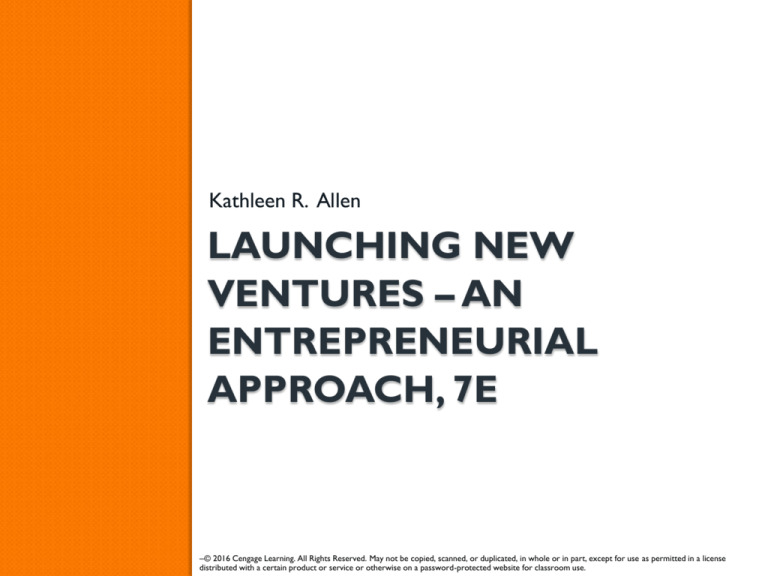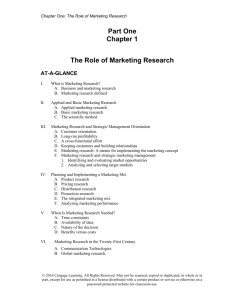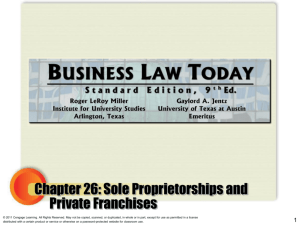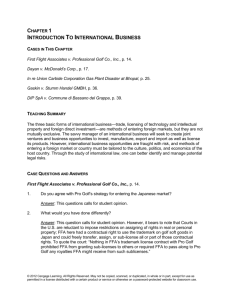
Kathleen R. Allen
LAUNCHING NEW
VENTURES – AN
ENTREPRENEURIAL
APPROACH, 7E
–© 2016 Cengage Learning. All Rights Reserved. May not be copied, scanned, or duplicated, in whole or in part, except for use as permitted in a license
distributed with a certain product or service or otherwise on a password-protected website for classroom use.
Incorporating Ethics and Social
Responsibility into the Business
Chapter 15
–© 2016 Cengage Learning. All Rights Reserved. May not be copied, scanned, or duplicated, in whole or in part, except for use as permitted in a license distributed with a certain product or
service or otherwise on a password-protected website for classroom use.
Chapter Objectives
Explain the role of ethics in
entrepreneurship
List the types of ethical situations
entrepreneurs may face
Discuss how entrepreneurs can
demonstrate social responsibility
Describe how an entrepreneur’s vision and
values contribute to the culture of the new
venture
–© 2016 Cengage Learning. All Rights Reserved. May not be copied, scanned, or duplicated, in whole or in part, except for use as permitted in a license distributed with a certain product or
service or otherwise on a password-protected website for classroom use.
Chapter Objectives
Discuss the relationship of core values to success
–© 2016 Cengage Learning. All Rights Reserved. May not be copied, scanned, or duplicated, in whole or in part, except for use as permitted in a license distributed with a certain product or
service or otherwise on a password-protected website for classroom use.
Incorporating Ethics and Social
Responsibility into the Business
Shareholder value is often considered more
important than basic human values
◦ The pressure to achieve unattainable goals and
sustain a business in a chaotic environment causes
stress, which leads to unwise decisions
◦ The global economy easily navigated via the
Internet puts us in contact with cultures that may
define morality differently
◦ Yet we expect our employees to navigate this
environment through the lens of the company’s
ethics
–© 2016 Cengage Learning. All Rights Reserved. May not be copied, scanned, or duplicated, in whole or in part, except for use as permitted in a license distributed with a certain product or
service or otherwise on a password-protected website for classroom use.
Incorporating Ethics and Social
Responsibility into the Business
Most entrepreneurs, executives and
employees are not inherently unethical, but
are often placed in situations that ignore or
reward unethical behavior; consider:
◦ We set goals and incentivize employees based on those
goals, but this may encourage bad behavior
◦ We pretend there is no unethical behavior if it serves our
interests
◦ We don’t see unethical behavior if it comes on gradually
◦ We tend to ignore unethical behavior when the outcome is
positive
–© 2016 Cengage Learning. All Rights Reserved. May not be copied, scanned, or duplicated, in whole or in part, except for use as permitted in a license distributed with a certain product or
service or otherwise on a password-protected website for classroom use.
15.1
Ethics
Ethics is the moral code by which we live and
conduct business
◦ The concept of right and wrong which derives
from the cultural, social, political and ethnic
norms with which we were raised as children
◦ We don’t often reflect on our value system, we
act instinctively based on it
◦ Many believe that following the Golden Rule
keeps them safe from ethical dilemmas
This is not true
–© 2016 Cengage Learning. All Rights Reserved. May not be copied, scanned, or duplicated, in whole or in part, except for use as permitted in a license distributed with a certain product or
service or otherwise on a password-protected website for classroom use.
15.1
Ethics
Ethics is the moral code by which we live and
conduct business
◦ Most ethical dilemmas are not huge scandals
involving criminal conduct, but small, common
dilemmas encountered regularly
◦ Avoiding criminal acts is not the same as acting
ethically
◦ Being ethical is about doing the right thing all
the time – and being proud of acting honorably
◦ But the business environment has many “gray
areas”
–© 2016 Cengage Learning. All Rights Reserved. May not be copied, scanned, or duplicated, in whole or in part, except for use as permitted in a license distributed with a certain product or
service or otherwise on a password-protected website for classroom use.
15.1
Ethics
Most ethical dilemmas require balancing
conflict among ideals, duty, and utility
As this is difficult, many avoid it by adopting:
◦ 1. Dogmatism: “I simply will never lie or cheat or
steal.”
◦ 2. Egoism: “Everyone needs to look out for
himself.”
◦ 3. Relativism or situational: “When in Rome, do
what the Romans do.”
◦ 4. Subjectivism: “Ethics is simply a point of view.”
–© 2016 Cengage Learning. All Rights Reserved. May not be copied, scanned, or duplicated, in whole or in part, except for use as permitted in a license distributed with a certain product or
service or otherwise on a password-protected website for classroom use.
Figure 15.1- The Elements
of Ethical Action
–© 2016 Cengage Learning. All Rights Reserved. May not be copied, scanned, or duplicated, in whole or in part, except for use as permitted in a license distributed with a certain product or
service or otherwise on a password-protected website for classroom use.
15.1a
Conflicts of Interest
Occurs when a person’s private or personal
interests clash with his or her professional
obligations
◦ an independent observer might reasonably
question whether the person’s actions are
influenced by personal gain
An online firm can track and gather
information about customers, profile them,
and share this information with others
◦ See the example of Facebook
–© 2016 Cengage Learning. All Rights Reserved. May not be copied, scanned, or duplicated, in whole or in part, except for use as permitted in a license distributed with a certain product or
service or otherwise on a password-protected website for classroom use.
15.1b
Survival Tactics
Many are the stores of entrepreneurs who did
whatever it took to survive, even violating
their own standards to do it
When it comes to survival, ethics are tested
Sticking to an ethical code is critical, because
what you do today out of desperation will
follow you for the rest of your business career
–© 2016 Cengage Learning. All Rights Reserved. May not be copied, scanned, or duplicated, in whole or in part, except for use as permitted in a license distributed with a certain product or
service or otherwise on a password-protected website for classroom use.
15.1c
Responding to Incentives
Sometimes entrepreneurs inadvertently make
it easy for their employees to participate in
unethical behavior
◦ An unintended consequence of badly designed
incentives
◦ Have procedures in place that make it difficult for
employees to act unethically
What is considered unethical differs between
Western and Eastern cultures, and by those
who work in the private and public sectors
–© 2016 Cengage Learning. All Rights Reserved. May not be copied, scanned, or duplicated, in whole or in part, except for use as permitted in a license distributed with a certain product or
service or otherwise on a password-protected website for classroom use.
15.1d
Stakeholder Pressure
Stakeholders include investors, shareholders,
suppliers, customers, employees and others
◦ Stakeholders may want you to take an action you
are not certain is right for the company
Research has revealed that the most healthy
outcome is realized when you hold to your
code of ethics and base decisions on it, not on
the personal agendas of stakeholders
–© 2016 Cengage Learning. All Rights Reserved. May not be copied, scanned, or duplicated, in whole or in part, except for use as permitted in a license distributed with a certain product or
service or otherwise on a password-protected website for classroom use.
15.1e
Pushing the Legal Limit
Some entrepreneurs seek ways to bend the
law without breaking it
But those who play too close to the edge are
caught and the price is high
◦ Loss of the business
◦ Loss of their reputations
Your reputation must be protected at all costs;
without it, chances are there will be no
business
–© 2016 Cengage Learning. All Rights Reserved. May not be copied, scanned, or duplicated, in whole or in part, except for use as permitted in a license distributed with a certain product or
service or otherwise on a password-protected website for classroom use.
Learning from
Real-Life Dilemmas
15.1f
There is no better way to understand the role
of ethics in any business than to encounter
real-world dilemmas and think about how you
might deal with them
◦ See the examples in the text, numbered 1-5
Small businesses are as guilty as
multinationals of ethical missteps
Aristotle said that courage is the first of the
human virtues because without it, the others
are not possible
–© 2016 Cengage Learning. All Rights Reserved. May not be copied, scanned, or duplicated, in whole or in part, except for use as permitted in a license distributed with a certain product or
service or otherwise on a password-protected website for classroom use.
The Importance of Developing
a Code of Ethics
15.1g
The ethical behavior of employees is much
influenced by the code of ethics of the firm
When a code of ethics is spelled out, written
down, people in the firm take it more seriously
–© 2016 Cengage Learning. All Rights Reserved. May not be copied, scanned, or duplicated, in whole or in part, except for use as permitted in a license distributed with a certain product or
service or otherwise on a password-protected website for classroom use.
The Importance of Developing
a Code of Ethics
15.1g
The Process of Developing a Code of Ethics
◦ Begin with self-examination to identify values
◦ The founding team should discuss how issues
should be dealt with
◦ Consider the values represented in Table 15.1
◦ For an ethical decision to be made, ask:
1. Will the actions taken result in the greatest good for all
parties involved?
2. Will the actions respect the rights of all parties?
3. Are the actions just? Will anyone be hurt?
4. Would I be proud of my actions if reported in the news?
–© 2016 Cengage Learning. All Rights Reserved. May not be copied, scanned, or duplicated, in whole or in part, except for use as permitted in a license distributed with a certain product or
service or otherwise on a password-protected website for classroom use.
Table 15.1Character Counts Inventory
–© 2016 Cengage Learning. All Rights Reserved. May not be copied, scanned, or duplicated, in whole or in part, except for use as permitted in a license distributed with a certain product or
service or otherwise on a password-protected website for classroom use.
15.2
Social Responsibility
Social responsibility:
◦ It is not enough to have a successful business and
make a profit
◦ Many would argue that the business must give
something back to the communities in which it
does business, and to society at large
Acting in a socially responsible manner
means exceeding the ethical, legal,
commercial and public expectations society
has of a business
–© 2016 Cengage Learning. All Rights Reserved. May not be copied, scanned, or duplicated, in whole or in part, except for use as permitted in a license distributed with a certain product or
service or otherwise on a password-protected website for classroom use.
15.2
Social Responsibility
Some entrepreneurs have chosen to make
social responsibility the reason for the
existence of the business
◦ They are faced with different challenges as they
seek resources to fund and sustain the business
◦ Their rewards derive not only from profits but also
from the social value they create
◦ This is known as a triple bottom line strategy:
People, planet, profit
–© 2016 Cengage Learning. All Rights Reserved. May not be copied, scanned, or duplicated, in whole or in part, except for use as permitted in a license distributed with a certain product or
service or otherwise on a password-protected website for classroom use.
Effective Ways to Become
Socially Responsible
15.2a
◦ Target disadvantaged markets
◦ Employ disadvantaged individuals
◦ Procure products and supplies from emerging
economies, from environmentally conscious
sources
◦ Create products or services that have social value
◦ Donate products, services or revenues
◦ Donate expertise
◦ Produce for social good
–© 2016 Cengage Learning. All Rights Reserved. May not be copied, scanned, or duplicated, in whole or in part, except for use as permitted in a license distributed with a certain product or
service or otherwise on a password-protected website for classroom use.
11.3
Vision and Values
Every great company begins with the
entrepreneur’s vision of what it will become
It is difficult, if not impossible to become a
great company without a vision
◦ The number one company in any industry
outperformed its next competitor significantly,
because of their strong vision and core values
◦ Performance suffered when they strayed from
those core values
–© 2016 Cengage Learning. All Rights Reserved. May not be copied, scanned, or duplicated, in whole or in part, except for use as permitted in a license distributed with a certain product or
service or otherwise on a password-protected website for classroom use.
Figure 15.2- The Components of
Company Vision
–© 2016 Cengage Learning. All Rights Reserved. May not be copied, scanned, or duplicated, in whole or in part, except for use as permitted in a license distributed with a certain product or
service or otherwise on a password-protected website for classroom use.
15.3a
Core Values
These are the fundamental believes a
company holds about business and life
They are based on the personal values and
beliefs of the founder or the founding team
These tell the world who the firm is and what
it stands for
Because they are so fundamental to its
existence, core values rarely change over
time, and they endure beyond the founder
–© 2016 Cengage Learning. All Rights Reserved. May not be copied, scanned, or duplicated, in whole or in part, except for use as permitted in a license distributed with a certain product or
service or otherwise on a password-protected website for classroom use.
15.3b
Purpose
This is your company’s fundamental reason
to be in business
◦ Why does the business exist?
◦ Not necessarily a unique characteristic of the
business
◦ What is crucial is that the purpose be authentic,
must mean what it says
◦ A properly conceived purpose will be broad,
enduring and inspiring, and allow the company to
grow and diversity
–© 2016 Cengage Learning. All Rights Reserved. May not be copied, scanned, or duplicated, in whole or in part, except for use as permitted in a license distributed with a certain product or
service or otherwise on a password-protected website for classroom use.
15.3c
Mission
This brings everyone together to achieve a
common objective; closely related to purpose
◦ A mission is an overriding objective that mobilizes
everyone to achieve it; examples include:
Starbucks: “Our mission: to inspire and nurture the
human spirit – one person, one cup and one
neighborhood at a time.”
Facebook: “Giving people the power to share and make
the world more open and connected.”
Leader to Leader Institute: “To strengthen the leadership
of the social sector.”
–© 2016 Cengage Learning. All Rights Reserved. May not be copied, scanned, or duplicated, in whole or in part, except for use as permitted in a license distributed with a certain product or
service or otherwise on a password-protected website for classroom use.
15.3d
Strategies and Tactics
Once goals are set, develop strategies, the
plans for achieving goals, and ultimately,
accomplishing the mission
◦ Tactics, which are the means to execute
strategies, should also be put in place
◦ You will need to choose a variety of tactics, or
ways to implement your strategies
Merely setting a goal is not enough; a plan for
achieving the goal is required
–© 2016 Cengage Learning. All Rights Reserved. May not be copied, scanned, or duplicated, in whole or in part, except for use as permitted in a license distributed with a certain product or
service or otherwise on a password-protected website for classroom use.
15.4
Core Values and Success
Your personal definition of success – what it
means to be successful – is a function of the
core values and vision you have for your life
◦ The success of a business can be measured in total
revenues, etc., but you don’t typically measure
your personal success solely in these terms
◦ Research has shown that the personal rewards
that motivate entrepreneurs to start businesses
are independence and freedom
Being one’s own boss; being in control of one’s destiny
–© 2016 Cengage Learning. All Rights Reserved. May not be copied, scanned, or duplicated, in whole or in part, except for use as permitted in a license distributed with a certain product or
service or otherwise on a password-protected website for classroom use.
15.4a
Constants of Success
There are four constants that seem to
permeate everyone’s definition of success:
◦
◦
◦
◦
Purpose
Failure
Sense of satisfaction with work
No free lunch
Firm core values and ethics plus a socially
responsible business can lead to the kind of
success that is meaningful to most
entrepreneurs
–© 2016 Cengage Learning. All Rights Reserved. May not be copied, scanned, or duplicated, in whole or in part, except for use as permitted in a license distributed with a certain product or
service or otherwise on a password-protected website for classroom use.
New Venture Action Plan
Identify the core values held by the
founding team
Develop an initial code of ethics for the
business
List possible ways your business can be
socially responsible
Define what success means to you
–© 2016 Cengage Learning. All Rights Reserved. May not be copied, scanned, or duplicated, in whole or in part, except for use as permitted in a license distributed with a certain product or
service or otherwise on a password-protected website for classroom use.








